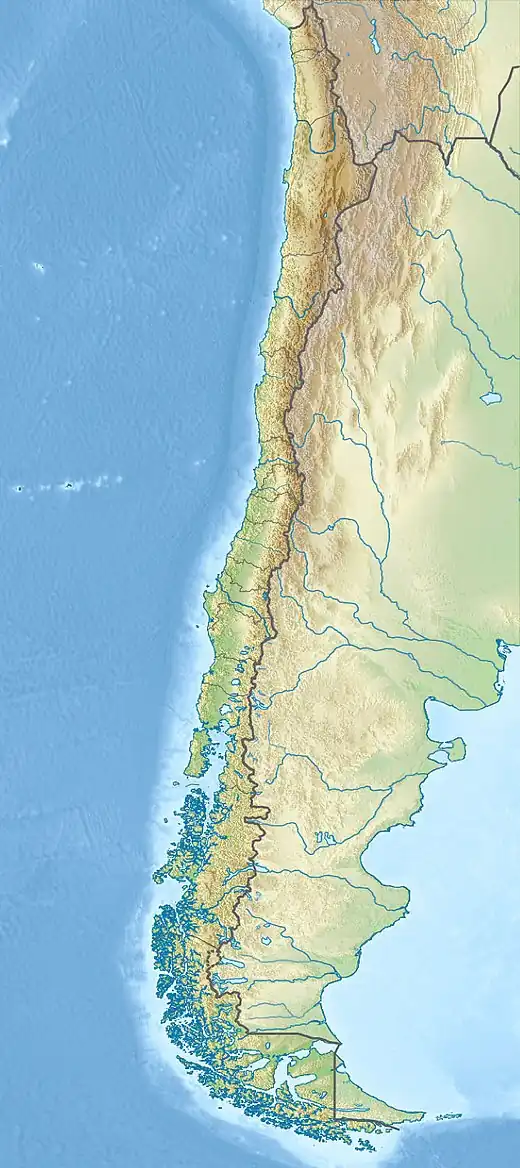California Valley, Chile
| California Valley | |
|---|---|
| Valle de California, Valle California | |
 California Valley Location of the valley in Chile | |
| Geology | |
| Type | Glacial valley |
| Geography | |
| Location | Palena, Región de Los Lagos, Chile |
| Country | |
| State/Province | Región de Los Lagos |
| District | Palena |
| Borders on | Argentina–Chile border |
| Coordinates | 43°40′33″S 71°41′51″W / 43.675833°S 71.6975°W |
| River | Río Encuentro, Río El Salto |
| Location | |
The California Valley or Valle California is a Chilean valley located in the commune of Palena, in the Alto Palena area, Los Lagos Region, between boundary markers 16 and 17 of the Argentina–Chile border. The valley has had Chilean settlers since the beginning of the 20th century and was claimed by Argentina in the Alto Palena–Encuentro River dispute, even occupying part of the area in the 1950s, which ended in 1966 with an arbitral award.[1]
Climate
The climate is continental climate. The average temperature is 3 °C. The warmest month is February, with 12 °C, and the coldest is July, with −6 °C.[2] The average annual precipitation is 3,085 millimetres. The wettest month is December, with 350 millimetres, and the driest is September, with 169 millimetres.[3]
History

On 2 May 1956, Chilean settlers in the California Valley, Alto Palena[1] were notified by Argentine authorities from Esquel that they should request Argentine property titles. The Carabineros instructed the population to ignore the order and notified the commander of the Gendarmerie in Esquel that the Carabineros would prevent their actions, as it was a violation of the status quo agreed upon between the two countries.[4]
On 3 November 1958, Argentine gendarmes again entered the disputed area.
On 22 March 1960, Frondizi and Alessandri signed in Santiago, Chile the Joint Declaration on Arbitration. The two presidents agreed to submit the boundary dispute in the Río Encuentro area and the valleys of Palena and California to arbitration by Queen Elizabeth II of Great Britain (or, failing that, the President of Switzerland), while the Beagle Channel dispute would be submitted to the International Court of Justice in The Hague.[5]
In the California Valley, Alto Palena, occupied by Argentine gendarmes since 1958, a serious incident was almost witnessed in 1965 due to the tense atmosphere. A group of gendarmes, led by an Argentine sub-lieutenant, attempted to assault an unarmed Chilean settler, which led Foreign Minister Gabriel Valdés to lodge a formal protest. The Chilean press, in turn, began a campaign to cancel President Frei Montalva's visit to Argentina, whose purpose was precisely to advance the pending tasks of border demarcation between the two countries.
The response from Argentina took several days to arrive. Finally, Foreign Minister Zavala Ortiz visited Santiago briefly and claimed to be unaware of what had happened in the California Valley. However, upon being informed of the details of the incident, President Illia ordered the removal of the Argentine sub-lieutenant responsible for the patrol.
This gesture was considered satisfactory by the Chilean government, which allowed the presidential visit plans to resume. Frei Montalva arrived in Mendoza on 30 October, where he was received cordially, giving the impression that recent conflicts had been left behind. During the meeting, the leaders agreed to complete the activities of the joint commission within five years and signed a commitment to submit the Beagle Channel conflict to international arbitration, although this agreement was not implemented in practice.[6]
Following the 1966 award, Chilean Foreign Minister Gabriel Valdés declared that[7] "the Award fully confirms Chilean sovereignty over the California Valley, which has long been settled by Chile, in a correct understanding of the 1902 award." He added that the ruling rejects the decision made in 1955 by the Joint Boundary Commission regarding the course of the Río Encuentro and accepts the Chilean thesis that the river originates in the Cordón de la Vírgenes. It assigns to Argentina the more mountainous, uninhabited region in the south of the disputed area."[8]
The demarcation on the ground was to be carried out in the summer of 1966–1967[9] beginning no later than 7 January 1967. About 420 km² of fertile disputed land was awarded to Argentina, including the Norte and Hondo valleys, the rich Río Engaño region and Laguna del Engaño, as well as maintaining the occupation of the Valle de las Horquetas by the Argentine Gendarmerie.[10] Meanwhile, the California Valley, the most fertile part of the disputed territory, was awarded to Chile.[11]
References
- ^ a b Manuel Hormazábal González (1965). Palena y California, Tierras Chilenas. Chile: Editorial del Pacífico.
- ^ "NASA Earth Observations Data Set Index". NASA. Retrieved 30 January 2016.
- ^ "NASA Earth Observations: Rainfall (1 month - TRMM)". NASA/Tropical Rainfall Monitoring Mission. Retrieved 30 January 2016.
- ^ "Autoridades argentinas violaron Statu Quo en zona de Alto Palena" (PDF). Santiago, Chile: La Nación. 3 May 1956. Retrieved 24 December 2024.
- ^ Pedro Espina Ritchie (1962). LOS PROBLEMAS LIMITROFES CON ARGENTINA - PROTOCOLOS DE ARBITRAJE DE JUNIO DE 1960 (PDF). Santiago, Chile: Comité Patria y Soberanía. Retrieved 24 December 2024.
- ^ "El día que mataron al teniente Merino en la Laguna del Desierto". Diario Palena. 4 October 2023. Retrieved 24 December 2024.
- ^ Óscar Pinochet de la Barra. "Palena: Un conflicto que termino bien" (PDF). Retrieved 24 December 2024.
- ^ Carlos Fortín Gajardo (1967). Historia General de Chile. Editorial Pedro Modeiro y Cía.
- ^ Exequiel González Madariaga (12 April 1967). "ANALISIS DEL LAUDO E INFORME ARBITRAL DE S. M. LA REINA ISABEL DE INGLATERRA EN EL CASO DE PALENA" (PDF). Session 8~, Wednesday 12 April 1967. Biblioteca del Congreso Nacional de Chile. Retrieved 24 December 2024.
- ^ Francisco Ghisolfo Araya (1983). "DIFERENDO LIMITROFE AUSTRAL: ORIGEN Y DESARROLLO" (PDF). Revista Marina. Retrieved 24 December 2024.
- ^ Jaime Eyzaguirre (1967). Breve Historia de las Fronteras de Chile.